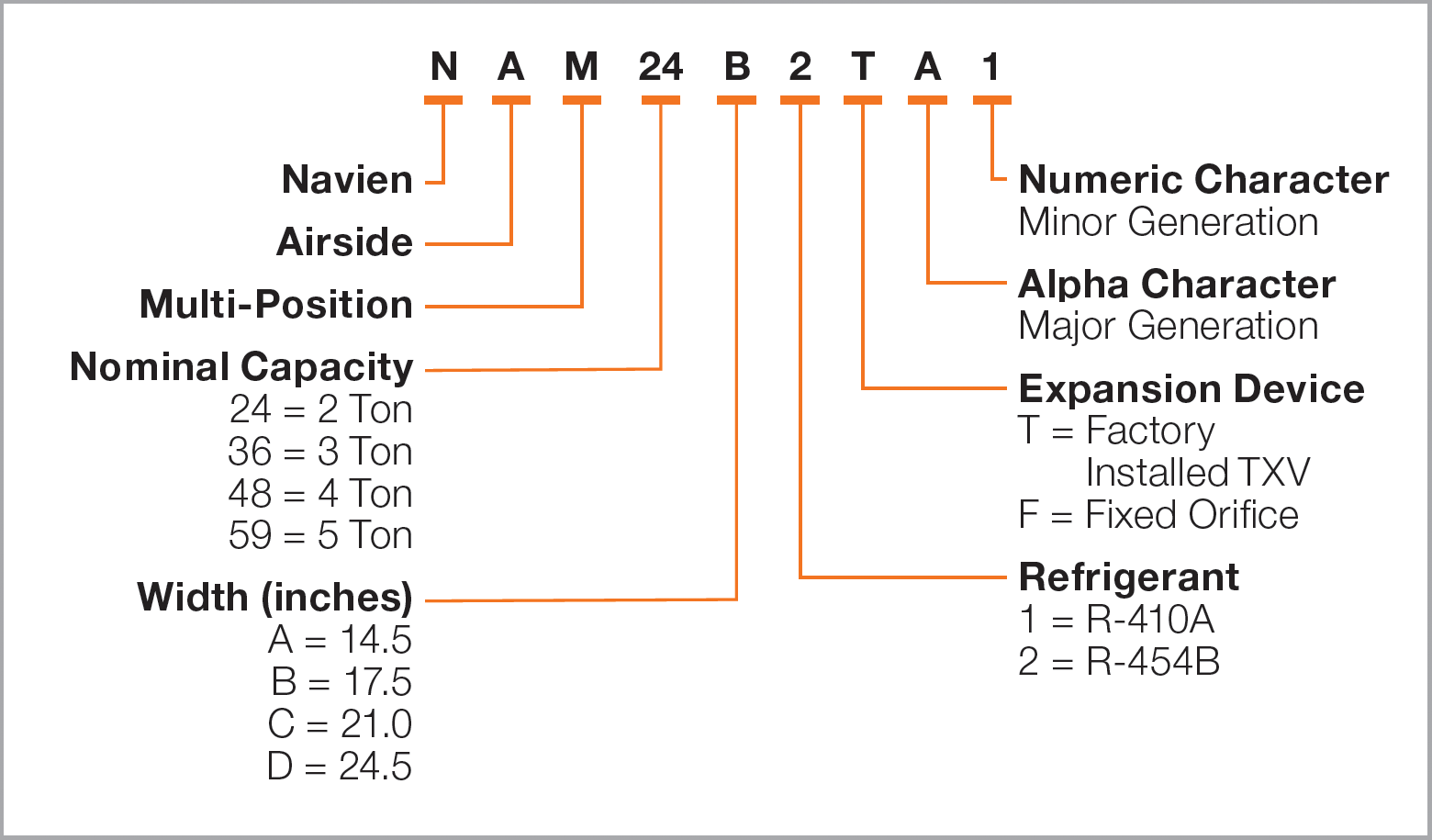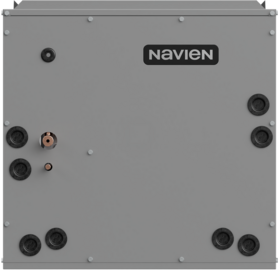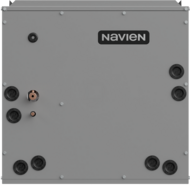NAM36C premium features and benefits


Copper sweat connections.
Shipped with a nitrogen holding charge.

Factory installed and calibrated TXV.

Factory installed A2L refrigerant sensor and mitigation control.
Model Number Guide

NAM36C QuickFacts
21.0" W x 21.0" H x 20.0" D (53.3cm W x 53.3cm H x 50.8cm D)
Product approvals
- AHRI Certified
- Yes
- UL Certified
- Yes
| Item | NAM36C | |
|---|---|---|
| Dimensions | 21.0" W x 21.0" H x 20.0" D (53.3cm W x 53.3cm H x 50.8cm D) | |
| Capacity | 3 Tons | |
| Refrigerant | R-454B | |
| Tube Material | Aluminum | |
| Tube Type | Rifled | |
| Fin Material | Aluminum | |
| Fin Type | Lanced | |
| Certifications | AHRI, UL Certified | |
Navien reserves the right to change specifications at any time without prior notice.
| NAM Series - Coverage Table for Labor and Parts Only | |||
| Residential2 | Commercial | ||
| Parts1 | Registered3 | 10 Years | 1 Year |
| Non-Registered4 | 5 Years | ||
| Labor | 90 Days | ||
Definitions:
Parts1 – refers to all internal functional components of the unit, except for the Combustion Heat Exchanger
Residential2 – Refers to a Single-Family, residential application.
Registered3 – Refers to coverages for units registered within 60 days of the Commencement date.
Non-Registered4 – Refers to coverages for units registered 61 days or more after the Commencement Date
| Wet Air Pressure Drop (in-WC) | ||||||||
| Model | 600 cfm | 800 cfm | 1000 cfm | 1200 cfm | 1400 cfm | 1600 cfm | 1800 cfm | 2000 cfm |
| NAM24B2TA1 | 0.13 | 0.15 | 0.21 | 0.29 | ||||
| NAM36B2TA1 | 0.13 | 0.15 | 0.21 | 0.29 | 0.37 | |||
| NAM36C2TA1 | 0.09 | 0.14 | 0.20 | 0.27 | 0.34 | 0.43 | ||
| NAM48C2TA1 | 0.08 | 0.10 | 0.13 | 0.16 | 0.20 | 0.24 | ||
| NAM59C2TA1 | 0.08 | 0.10 | 0.13 | 0.16 | 0.20 | 0.24 | ||
| NAM59D2TA1 | 0.07 | 0.09 | 0.12 | 0.15 | 0.18 | 0.22 | ||
| Dry Air Pressure Drop (in-WC) | ||||||||
| Model | 600 cfm | 800 cfm | 1000 cfm | 1200 cfm | 1400 cfm | 1600 cfm | 1800 cfm | 2000 cfm |
| NAM24B2TA1 | 0.09 | 0.09 | 0.13 | 0.17 | ||||
| NAM36B2TA1 | 0.09 | 0.09 | 0.13 | 0.17 | 0.25 | |||
| NAM36C2TA1 | 0.05 | 0.08 | 0.12 | 0.16 | 0.21 | 0.26 | ||
| NAM48C2TA1 | 0.05 | 0.06 | 0.08 | 0.10 | 0.12 | 0.15 | ||
| NAM59C2TA1 | 0.05 | 0.06 | 0.08 | 0.10 | 0.12 | 0.15 | ||
| NAM59D2TA1 | 0.04 | 0.06 | 0.08 | 0.10 | 0.12 | 0.14 | ||
Compare NAM models
NAM36C FAQs
What is the life expectancy of an evaporator coil?
10 to 15 years when properly maintained.
Is it better to replace an evaporator coil, or the whole unit?
The evaporator coil is intended to last for the lifespan of your entire heat pump system, which typically ranges from 10 to 15 years.
Other factors may lead to premature replacement, prompting homeowners to weigh the options between replacing only the indoor coil or investing in a new heat pump system.
Factors such as coil corrosion, leaks, or damage to the coil can affect system efficiency and effectiveness.
If your heat pump is still covered by a warranty, replacing just the evaporator coil may be the right option. In such cases, the outdoor portion of your heat pump system may have more years of useful life, extending time until a complete unit replacement is needed.
While replacing the indoor coil alone may seem like a cost-effective solution, it’s wise to consider replacing the indoor coil and the outdoor unit considering the following situations.
• System Age. If the indoor coil needs replacement and your heat pump is over 8 years old, it’s typically best to replace both components simultaneously, as the system is already halfway through its expected lifespan.
• Availability. It can be difficult to find a new indoor coil that’s compatible with an older heat pump units. Aligning these components ensures smooth operation and performance, reducing the chances of problems stemming from mismatched equipment.
• Warranty. If your heat pump is no longer under warranty, you’ll be responsible for any repair or replacement expenses, making it wise to consider replacing the entire heat pump system. New systems feature warranties that offer coverage against unforeseen repairs for a time period, usually 5-10 years.
• Efficiency. If your current heat pump is old and most likely inefficient, it will likely need to be replaced in the next couple of years. Opting for a new higher efficient heat pump system can decrease energy costs while improving the comfort level in your home.


